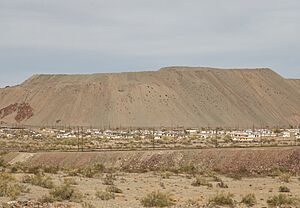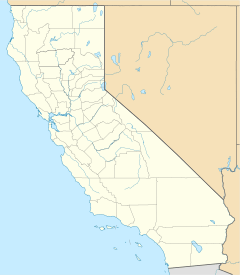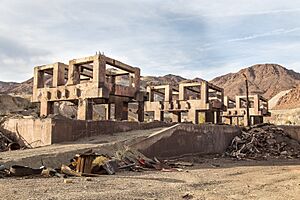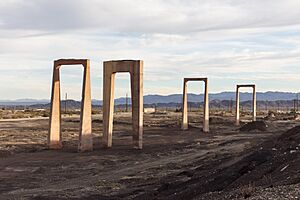Eagle Mountain, California facts for kids
Quick facts for kids
Eagle Mountain
|
|
|---|---|
 |
|
| Country | United States |
| State | California |
| County | Riverside |
| Elevation | 1,365 ft (416 m) |
| Time zone | UTC-8 (Pacific (PST)) |
| • Summer (DST) | UTC-7 (PDT) |
| GNIS feature ID | 1660573 |
Eagle Mountain is a ghost town located in the California desert. It's in Riverside County. A famous business leader named Henry J. Kaiser started the town in 1948.
The town was built right at the entrance of the Eagle Mountain iron mine. This mine used to be owned by the Southern Pacific Railroad and then by Kaiser Steel. Eagle Mountain is found on the edge of Joshua Tree National Park. The town also had a special healthcare system. This system was an early version of what is now the large Kaiser Permanente health organization. You can get to Eagle Mountain by taking Kaiser Road from California State Route 177. It's about 12 miles (19 km) north of Desert Center.
Contents
History of Eagle Mountain Town
Eagle Mountain was founded in 1948 by Kaiser Steel Corporation. It was built next to the Eagle Mountain iron mine. As the mine grew, the town also grew. At its busiest, about 4,000 people lived there.
The town had wide streets with over 400 homes. Some homes had up to four bedrooms. There were also places for workers to stay, like trailer spaces and dorms. Eagle Mountain had many cool things for its residents. These included an auditorium, a park, and a shopping center. There was also a community swimming pool, lighted tennis courts, and a baseball field. Other businesses included a bowling alley, two gas stations, eight churches, and three schools.
In the late 1930s, Kaiser built the first full steel mill on the West Coast. In 1942, a large steel mill was built in Fontana, California. This mill was about 112 miles (180 km) west of the Eagle Mountain Mine. Kaiser then bought the iron mines from the Southern Pacific Railroad. These mines provided high-quality iron ore for the steel mill.
The Fontana steel plant started making steel during World War II. Iron shipments from Eagle Mountain began in 1948. A special 51-mile-long (82 km) railroad, called the Eagle Mountain Railroad, was built. It carried the iron ore from the mine to the Salton Sea. From there, the ore went to the Fontana steel plant. Trains with 100 cars ran five to eight times a week. On August 17, 1977, the mine celebrated shipping its 100 millionth ton of iron ore.
Why Eagle Mountain Closed Down
In the 1970s, people became more worried about the environment. Also, steel companies from other countries started selling steel for less. These things caused the mine to produce less iron. Because of this, the town's population dropped.
In the summer of 1980, the mine closed for a short time. It reopened on September 23, but with fewer workers. Only 750 workers came back to Eagle Mountain. On November 3, 1981, Kaiser Corporation announced that the Eagle Mountain Mine would close completely.
As layoffs happened, fewer and fewer people lived in the town. The grocery store closed in October 1982. The post office, which had been open since 1951, closed in 1983. In June of that year, the last students graduated from Eagle Mountain High School. Soon after, both the mine and the steel mill closed for good. The town's ZIP code, 92241, was no longer used. Mail now goes to nearby Desert Center.
New Ideas for Eagle Mountain
Eagle Mountain saw some new activity in 1986. The California Department of Corrections and Rehabilitation suggested opening a special prison there. The old shopping center was turned into the Eagle Mountain Community Correctional Facility in 1988. This prison operated for a while but closed in December 2003. It closed because of state budget problems.
In 1988, there was also a plan to turn the huge open-pit mine into a large, modern landfill. This landfill would take trash by train from the Los Angeles area. The company behind the plan was Kaiser Ventures. However, many lawsuits were filed because of worries about how the landfill would affect the environment. These lawsuits caused many delays. In late 1999, the companies involved decided to stop the project.
Later, in 2000, Kaiser Ventures made a deal with the Los Angeles Sanitation District. They planned to buy the landfill project. The idea was to use it as a replacement for another landfill that was almost full. But things changed in the waste business. People started recycling more, so less trash was being made. Also, the Los Angeles Sanitation District bought another landfill site. In May 2013, the plans to turn the mine into a landfill were stopped.
A new idea came up for the mine: a large pumped-storage hydroelectricity plant. This plant would use water to create electricity. It would pump groundwater into two old mining pits. Water would be pumped from the lower pit to the upper pit when electricity demand is low. Then, when demand is high, the water would flow back down through turbines to make electricity. This project is supported by those who want more renewable energy in California. However, some environmental groups are worried about how it might affect plants and animals near Joshua Tree National Park.
On April 17, 2023, a company called Ecology Mountain Holdings bought the land and mining site. It's not yet known what they plan to do with the area.
Climate and Weather
Eagle Mountain has a very hot desert climate. This means it gets very hot and dry. The hottest temperature ever recorded in Eagle Mountain was 120°F (49°C) on June 26, 1970. The coldest temperature recorded was 20°F (-7°C) on January 22, 1937.
| Climate data for Eagle Mountain, California, 1991–2020 normals, extremes 1933–present | |||||||||||||
|---|---|---|---|---|---|---|---|---|---|---|---|---|---|
| Month | Jan | Feb | Mar | Apr | May | Jun | Jul | Aug | Sep | Oct | Nov | Dec | Year |
| Record high °F (°C) | 85 (29) |
91 (33) |
102 (39) |
105 (41) |
111 (44) |
120 (49) |
119 (48) |
118 (48) |
117 (47) |
109 (43) |
95 (35) |
85 (29) |
120 (49) |
| Mean maximum °F (°C) | 74.7 (23.7) |
78.3 (25.7) |
87.5 (30.8) |
95.6 (35.3) |
102.2 (39.0) |
109.6 (43.1) |
112.8 (44.9) |
110.5 (43.6) |
105.5 (40.8) |
97.4 (36.3) |
84.9 (29.4) |
73.8 (23.2) |
113.7 (45.4) |
| Mean daily maximum °F (°C) | 64.3 (17.9) |
68.0 (20.0) |
74.6 (23.7) |
81.5 (27.5) |
90.0 (32.2) |
99.4 (37.4) |
103.9 (39.9) |
102.8 (39.3) |
97.3 (36.3) |
85.5 (29.7) |
72.9 (22.7) |
63.2 (17.3) |
83.6 (28.7) |
| Daily mean °F (°C) | 55.2 (12.9) |
58.4 (14.7) |
64.5 (18.1) |
70.9 (21.6) |
79.5 (26.4) |
88.6 (31.4) |
93.6 (34.2) |
92.6 (33.7) |
86.7 (30.4) |
75.3 (24.1) |
63.3 (17.4) |
54.3 (12.4) |
73.6 (23.1) |
| Mean daily minimum °F (°C) | 46.1 (7.8) |
48.8 (9.3) |
54.5 (12.5) |
60.2 (15.7) |
68.9 (20.5) |
77.8 (25.4) |
83.4 (28.6) |
82.5 (28.1) |
76.2 (24.6) |
65.1 (18.4) |
53.8 (12.1) |
45.5 (7.5) |
63.6 (17.5) |
| Mean minimum °F (°C) | 37.8 (3.2) |
40.0 (4.4) |
44.4 (6.9) |
49.9 (9.9) |
56.5 (13.6) |
67.4 (19.7) |
74.8 (23.8) |
73.1 (22.8) |
66.5 (19.2) |
54.6 (12.6) |
43.7 (6.5) |
37.1 (2.8) |
35.2 (1.8) |
| Record low °F (°C) | 20 (−7) |
29 (−2) |
31 (−1) |
40 (4) |
45 (7) |
47 (8) |
64 (18) |
63 (17) |
51 (11) |
37 (3) |
35 (2) |
25 (−4) |
20 (−7) |
| Average precipitation inches (mm) | 0.59 (15) |
0.60 (15) |
0.40 (10) |
0.07 (1.8) |
0.07 (1.8) |
0.01 (0.25) |
0.28 (7.1) |
0.41 (10) |
0.36 (9.1) |
0.13 (3.3) |
0.11 (2.8) |
0.62 (16) |
3.65 (92.15) |
| Average precipitation days (≥ 0.01 in) | 2.7 | 2.8 | 2.0 | 0.9 | 0.3 | 0.1 | 1.2 | 1.8 | 1.5 | 1.1 | 0.9 | 1.8 | 17.1 |
| Source 1: NOAA | |||||||||||||
| Source 2: National Weather Service | |||||||||||||
Schools in Eagle Mountain
The Desert Center Unified School District once ran four schools in the Eagle Mountain and Desert Center areas. Eagle Mountain Elementary School was in the middle of town. Henry J. Kaiser Junior High School and Eagle Mountain High School were on the east side. Desert Center Elementary School was 11 miles away in Desert Center.
The class of 1987 was the last to graduate from Eagle Mountain High School. In 1987, the high school building was changed into the Eagle Mountain Elementary School. This school had been open since 1983 and taught students from kindergarten to 8th grade.
The other three school buildings were closed. Now, high school students from the area take a bus to Palo Verde High School in Blythe, California. This is a 120-mile round trip every day. The few remaining students in the school district are children of people living in Desert Center. They are also children of workers at two nearby water pumping plants.
Eagle Mountain in Movies and TV
Eagle Mountain has been used as a filming location for many movies and TV shows.
Movies Filmed Here
A part of the Eagle Mountain Railroad was used in the 1986 movie Tough Guys. In one scene, a train is hijacked and driven very fast towards the Mexican border. During the filming, the train was kept overnight at the Eagle Mountain rail yards. Local school children from Eagle Mountain School even took a field trip to see the train.
Other movies that used locations in Eagle Mountain include:
- The Professionals (1966)
- T2-3D: Battle Across Time (1996)
- Impostor (2001)
- Live from Baghdad (2002)
- Constantine (2003)
- The Island (2005)
- Unknown (2006)
- Battle of Los Angeles (2011)
- Video Game High School (2012)
- Tenet (2020)
TV Shows Filmed Here
The TV show Top Gear USA has used Eagle Mountain at least three times.
- In one episode, Eagle Mountain was used for a challenge where trucks had to pull down a house.
- In another episode, a Subaru WRX car raced against a motorcycle.
- The final challenge of a Top Gear USA episode called 'Doomsday Drive' was also filmed at Eagle Mountain. It was made to look like a world after an apocalypse.




